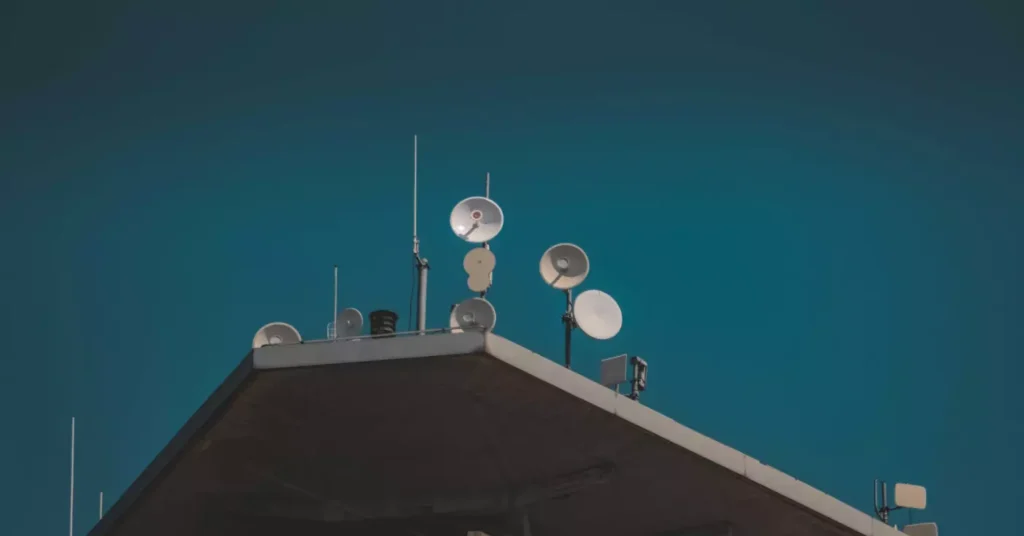What Is A Wireless Bridge? A Comprehensive Guide

If we see the most common questions of the networking world, “how do you interconnect two networks?” will win the contest. It is a very common problem, especially for companies with multiple sites and a single site but multiple buildings or those in remote areas who want to solve this question.
You may think the answer is obvious and that two networks are connected by running a cable between them. But it is not always a solution. There are different ways of connecting two internet connections, and a wireless bridge is one of those solutions.
Here in this article, we will describe everything you need to know about wireless bridges.
What Is A Wireless Bridge?
A wireless bridge is a networking device that allows you to connect two networks over a wireless channel by making a bridge, as its name shows. It connects two endpoints, which can be buildings on the same campus, CCTV cameras, telecommunication mast or any IP device you want to link. You may find that a wireless bridge is also known as a WiFi bridge.
These wireless bridges use radio (RF) signals in the microwave or laser links to interconnect two access points. They usually use high-directional antennae to send and receive wireless signals on one side and connect to a regular IP network on the other side. In this way, a wireless link connects two IP networks.
Wireless bridges are sometimes also called free-to-air bridges because they transmit and receive signals through the air using optical receptors or antennas. Since a wireless bridge is created between two transceivers, these links are point-to-point.
How Wireless Bridges Are Useful?
Now that you understand what a wireless bridge is, you may be thinking why there is a need to go through all this trouble. So let’s see how it is useful to create a wireless bridge.
The typical response is that establishing a physical connection is necessary, eliminating the possibility of using a VPN. Moreover, wired links may not be a viable alternative, especially in certain regions of London where high-speed leasing lines can be excessively expensive or unavailable altogether.
Due to technical constraints, constructing and managing a wired infrastructure over long distances can be costly and sometimes unfeasible. Furthermore, public authorities may require various permits for this type of undertaking.
In summary, a wireless bridge might be the only practical choice in certain situations.
Following are some most common reasons for deploying a wireless bridge:
- Leased lines are highly expensive and unavailable in all areas, and you can not use VPN for bandwidth, latency or security reasons.
- A fast internet connection is unavailable at the two endpoints, and a wired link can not be deployed.
- A wired link may be deployed, but it takes a long time, and you do not expect to use this link for long enough to be worth the initial effort.
- Due to electrical interference in your area, ethernet connections are impossible to install, and long-distance fibre links are too expensive.
- Deploying a wired link is impossible due to technical or legal reasons. One of the involved parties is not approving deployment or when cables must be deployed over inaccessible terrain.
Which Type Of Performance Can You Expect From Wireless Bridge?
Two sets of parameters define the performance of a wireless bridge, including bandwidth and range of internet connection.
In terms of distance, a wireless bridge can cover a distance of a few dozen metres to a few dozen kilometres, comparable to a WiFi access point. Typically this distance is between 50 to 60 km.
Regarding performance, the practical cap on bandwidth ranges between 1-1.25 Gbps with a latency that is almost similar to a leased line or even better than this. As a rule of thumb, you expect better latency than your internet connection over a VPN. However, the exact numbers depend on the technology and equipment used in creating a wireless bridge.
We can say that wireless bridges are inherently better or worse than other interconnection technologies. Just like VPN connections over public networks or wired bridges over leased lines, they excel in some aspects but not others.
Let’s understand it with an example. Suppose you develop the following data exchange method: copy the data on 32GB USB sticks, put all these USBs in a box and drive from one office to another.
It may take 45 minutes to cover the distance between two offices, but you are carrying data of 3.2TB if you have 100 USBs in the box. It is a large amount of data, and you may think it is worth spending 45 minutes transferring it.
However, if you use the same data transfer method even to send a 4MB image, it will still take 45 minutes, nearly 100 times more than the time to transfer this data over a broadband connection.
That is latency, the time required to transfer data over an internet connection. With a high bandwidth and low latency connection, you can transfer more data in less time.
Types Of Wireless Bridges

Understanding wireless bridges is a surprisingly confusing topic. You may find seemingly unrelated results when you try to look up wireless bridges online. The wireless bridge is a technical term instead of specific technology. There are many ways to build a wireless bridge.
The most straightforward way to create a wireless bridge is through connected technology. It is divided into two main types:
- Radio or microwave bridges that use radio signals to receive or send data in the 2.4 to 80 GHz range.
- The second class is Free-space optics laser links that use optical signals for data transmission.
Which technology is used and in what way it depends on two important implications:
1. Licensed Vs License-Exempt Use
Operating in some regions of the radio spectrum requires a licence. It is a document issued by Ofcom that allows you to use specific equipment in a certain region.
It is important to emphasize that ensuring the proper operation of radio equipment is not merely a matter of bureaucratic pedantry.
Mishandling of such equipment can lead to potentially hazardous interference, which may not always be immediately apparent. While some may recall a comical incident from 2020, the risk of disrupting critical communication services is real.
However, some areas are far away from the regions of the spectrum and can be operated without a licence. However, it limits their range to only 1-2 km, but still, it is useful in certain cases.
2. Line Of Sight Vs Non Line Of Sight
Let’s imagine that instead of using a high-speed laser link, you’re relying on a laser keychain to transmit data in Morse code. However, for this to work, it’s essential that the person on the other end can see the laser pointer.
Now, if you were to upgrade from the low-quality keychain to a sophisticated high-speed laser setup, it would significantly enhance the data transmission rate.
However, one fundamental constraint remains: the light must travel directly to the other optical receptor. Since light only moves in straight lines, there must be an unobstructed, line-of-sight path between the two endpoints of the transmission. It is known as the Line of Sight connection.
When both endpoints are situated on the ground, the maximum distance that can be covered is approximately 4-5 km. Although extending this distance by elevating the antennae is possible, the range cannot be increased indefinitely as radio and optical signals weaken over distance.
While some technologies permit communication between endpoints that don’t have a direct, unobstructed line-of-sight, such links are known as non-Line-of-Sight (NLoS) links.
3. Radio Or Microwave Wireless Bridge
Radio bridges use radio signals to transfer data. In a technical sense, all the high-speed RF bridges presently in use function within the microwave region of the electromagnetic spectrum. However, primarily due to historical reasons, the term “microwave bridge” is more commonly used to refer to those that operate within the radio spectrum’s 30-80 GHz range.
Most high-throughput RF bridges used for long-distance communication are line-of-sight but can withstand some atmospheric conditions and obstacles. RF links cannot penetrate buildings but tolerate rain, fog, or foliage. RF relays can extend the range of RF bridges beyond line-of-sight. Licensing for RF bridges covers both licensed and licence-exempt regions of the spectrum.
In the UK, licence-exempt regions for RF bridges include 2.4 GHz, 5 GHz (bands A and B), and 60 GHz. The first two bands are commonly used for short-distance WiFi bridges, while the 60 GHz range can be used over longer distances, up to 1-1.5 km, to connect networks in adjacent buildings.
Unlicensed links are inexpensive and easy to install, making them an excellent alternative to leased lines in suburban or remote areas. However, the unlicensed spectrum regions in busy urban areas are often overcrowded, limiting their effectiveness.
4. FSO Laser Links
Free-space optics (FSO) laser links use optical signals to transmit and receive data wirelessly, making them appear similar to RF bridges. However, laser links have an advantage in that they are impervious to electrical and radio interference.
Radio signals can be disrupted by interference from sources like lightning, high-power electrical lines, or other licensed operators, even within the licensed region of the spectrum.
In contrast, medium- and short-range RF bridges near busy industrial floors or electrical stations can be subject to interference from equipment from the same company that operates the bridge.
Final Words - Wireless Bridge
A wireless bridge is a networking device that connects two networks over a wireless channel by making a bridge between them. It connects two endpoints: buildings on the same campus, CCTV cameras, telecommunication mast, or any IP device you want to link. Wireless bridges use radio (RF) signals in the microwave or laser links to interconnect two access points. They usually use high-directional antennae to send and receive wireless signals on one side and connect to a regular IP network on the other side. Wireless bridges are also known as WiFi bridges and are sometimes called free-to-air bridges because they transmit and receive signals through the air using optical receptors or antennas. Wireless bridges are point-to-point connections and can be used when running a cable between two networks is not viable.
Read More : What is DRaaS (Disaster Recovery as a Service)?
Read More : A Complete Understanding Of Leased Line Speed



